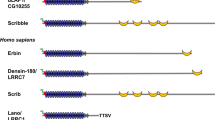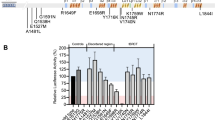Abstract
The BRCA1 gene encodes a tumor suppressor that has been implicated in hereditary forms of breast and ovarian cancer. During S phase of the cell cycle, BRCA1 polypeptides are found in discrete nuclear bodies (`BRCA1 nuclear dots') together with HsRad51, a human homolog of the E. coli recA protein, and BARD1, a protein that interacts with BRCA1 to form a stable heterodimer. BARD1 is structurally similar to BRCA1 in that both molecules harbor an amino-terminal RING domain and two carboxy-terminal BRCT domains. Here we describe the amino acid sequence and expression pattern of murine Bard1. A comparison of the mouse and human sequences reveals that the recognizable protein motifs of BARD1 are well conserved, including the RING domain, the three tandem ankyrin repeats, and, to a lesser extent, the two BRCT domains. However, the remaining sequences of BARD1 display a markedly lower degree of phylogenetic conservation, comparable to those reported for BRCA1 and BRCA2. Moreover, murine Bard1 retains the ability to associate in vivo with BRCA1, and its expression pattern in adult mice mirrors that of Brca1, with elevated levels of RNA transcripts found in the testes and spleen. These data suggest that BRCA1 and BARD1 have co-evolved to participate in a common pathway of tumor suppression.
This is a preview of subscription content, access via your institution
Access options
Subscribe to this journal
Receive 50 print issues and online access
$259.00 per year
only $5.18 per issue
Buy this article
- Purchase on Springer Link
- Instant access to full article PDF
Prices may be subject to local taxes which are calculated during checkout
Similar content being viewed by others
Author information
Authors and Affiliations
Rights and permissions
About this article
Cite this article
Ayi, TC., Tsan, J., Hwang, LY. et al. Conservation of function and primary structure in the BRCA1-associated RING domain (BARD1) protein. Oncogene 17, 2143–2148 (1998). https://doi.org/10.1038/sj.onc.1202123
Received:
Revised:
Accepted:
Published:
Issue Date:
DOI: https://doi.org/10.1038/sj.onc.1202123
Keywords
This article is cited by
-
A new bioinformatics tool to help assess the significance of BRCA1 variants
Human Genomics (2018)
-
Cancer predisposing BARD1 mutations in breast–ovarian cancer families
Breast Cancer Research and Treatment (2012)
-
Is there more to BARD1 than BRCA1?
Nature Reviews Cancer (2006)
-
Nuclear–cytoplasmic translocation of BARD1 is linked to its apoptotic activity
Oncogene (2004)



